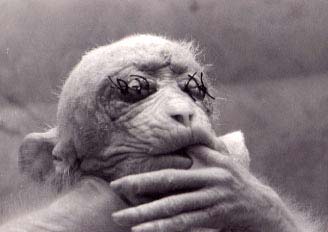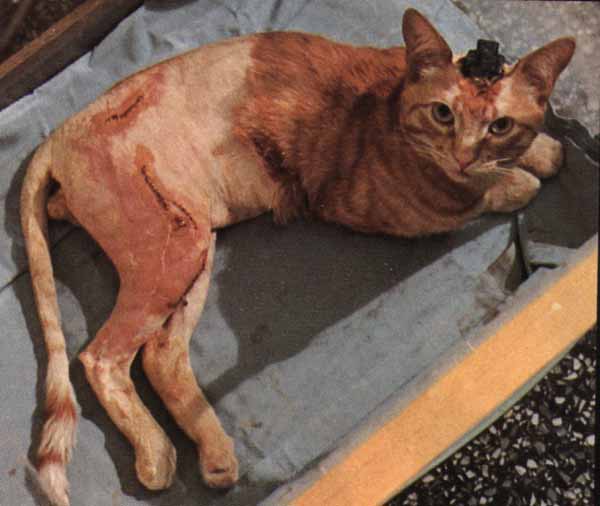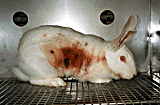

| Torturing
One Animal is Cruelty. Torturing Many Animals is Science? Every 3 seconds another animal dies In an American laboratory, full of lies. Alternatives aren't even used Instead an animal is abused. Poisons put in animal eyes Over and over until it dies. Breaking it's neck while fighting the pain These fucking tests have no gain. Animals are not our slaves In the name of safety many have died
Lyrics to the song Torturing one animal is cruelty. Torturing
many is science? played and compose by group ABULA |
Animal Experimentation
Animal experimentation intrinsically involves the incarceration of animals which itself causes intense psychological distress plus subsequent poisoning, mutilation, disease and the killing of those individuals. It is arguably the most brutal and most severe form of systematic, genocidal-scale violence in the modern world and yet it is called science.

Vivisection
Although
vivisection literally means 'to cut up alive', the term has come to
include all experiments involving animals, and not just those involving
dissection. Vivisection began because of religious prohibitions against
the dissection of human corpses. When religious leaders finally lifted
these prohibitions, it was too late - vivisection was already entrenched
in medical and educational institutions.
Estimates of the number of animals tortured
and killed annually in U.S. laboratories diverge widely - from 17 to
70 million animals. The Animal Welfare Act requires laboratories to
report the number of animals used in experiments, but the Act does not
cover mice, rats, and birds (used in some 80 to 90 percent of all experiments).
Because these animals are not covered by the Act, they remain uncounted
and we can only guess at how many actually suffer and die each year.
The largest breeding company in the United
States is Charles River Breeding Laboratories (CRBL) headquartered in
Massachusetts and owned by Bausch and Lomb. It commands 40-50 percent
of the market for mice, rats, guinea pigs, hamsters, gerbils, rhesus
monkeys, imported primates, and miniature swine.
Since mice and rats are not protected under
Animal Welfare Act regulations, the United States Department of Agriculture
(USDA) does not require that commercial breeders of these rodents be
registered or that the USDA's Animal and Plant Health Inspection Service
(APHIS) inspect such establishments. (4)
Dogs and cats are also used in experiments.
They come from breeders like CRBL, some animal shelters and pounds,
and organized "bunchers" who pick up strays, purchase litters
from unsuspecting people who allow their companion animals to become
pregnant, obtain animals from "Free to a Good Home" advertisements,
or trap and steal the animals. Birds, frogs, pigs, sheep, cattle, and
many naturally free-roaming animals (e.g., prairie dogs and owls) are
also common victims of experimentation. At this writing, animals traditionally
raised for food are covered by Animal Welfare Act regulations only minimally,
and on a temporary basis, when used in, for example, heart transplant
experiments; but they are not covered at all when used in agriculture
studies.

Unfortunately,
vivisectors are using more and more animals whom they consider less
"cute," because, although they know these animals suffer just
as much, they believe people won't object as strenuously to the torture
of a pig or a rat as they will to that of a dog or a rabbit.
Dissection
Dissection
is the practice of cutting into and studying animals. Every year, 5.7
million animals are used in secondary and college science classes. Each
animal sliced open and discarded represents not only a life lost, but
also just a small part of a trail of animal abuse and environmental
havoc.
Dissection teaches youth that animals
are merely resources for our disposal, not living organisms which experience
pain and suffering, and desire only to lead their lives. Humans must
learn the value of existence; cutting up animals in stils anthropocentric
(exclusively human-centered) values. Studying life does not require
destruction. Dissection overlooks.
Specific companies profit from supplying
the vast number of animals necessary for dissection. Biological supply
houses often obtain animals from pounds, shelters, slaughterhouses,
fisheries, fur farms and the wild. Taking animals from wild habitats
depletes the natural animal populations. This exploitation negatively
affects frog populations and insect control, resulting in crop damage.
If not taken from the wild, animals are bred explicitly for dissection,
again in poor conditions. At the supply houses, live animals are held
in unsanitary and substandard conditions, until they are gassed or injected
with formaldehyde
Animals in Cosmetic and other Product Test
Every year, millions of animals suffer and die in painful tests in order to determine the safety of cosmetics. Substances like eye shadow and soap are tested on rabbits, guinea pigs, rats, dogs, and many other animals, despite the fact that the test results do not help prevent or treat human illness or injury. According to the companies that perform these tests, animal testing is done to establish the safety of a product and the ingredients. However, the Food and Drug Administration (FDA) which regulates cosmetic products, does not require animal testing. Some of the tests used on animals are eye irritancy tests, acute toxicity tests, and skin irritancy tests.

In
eye irritancy tests, a liquid, flake, granule, or powdered
substance is dropped into the eyes of a group of albino rabbits. The
animals are often immobilized in stocks from which only their heads
protrude. They usually receive no anesthesia during the tests. After
placing the substance into the rabbit’s eyes, lab technicians
record the damage to the eye tissue at specific intervals over an average
period of 72 hours. The tests sometimes last seven to eighteen days.
Reactions to the substances include swollen eyelids, ulceration, bleeding,
swollen irises massive deterioration, and blindness. During the tests,
rabbits eyelids are usually held open with clips, because of this, many
animals break their necks as they try to escape.
Acute toxicity tests,
commonly called lethal dose or poisoning tests, determine the amount
of a substance that will kill a percentage, even up to one-hundred percent,
of a group of test animals. In these tests, a substance is forced by
tube into the animal’s stomach or through holes cut in their throats.
Experimenters observe the animal’s reactions which can include
convulsions, labored breathing, malnutrition, skin eruptions, and bleeding
from the eyes, nose, or mouth. The test was developed in 1927 and the
testing continues until at least fifty percent of the animals die (usually
takes 2-4 weeks). Like eye irritancy tests, lethal dose tests are unreliable
and have too many variables to have a constant result.
Skin irritancy tests are conducted on rabbits, guinea pigs and other animals. The process involves placing chemicals on the animals’ raw, shaved skin and covering the skin with adhesive plaster. The animals are immobilized in restraining devices to prevent them from struggling. Meanwhile, laboratory workers apply the chemicals which burn into the animal’s skin.
Experiment on Primates

Experimenting
on nonhuman primates in the hope of curing human neurological diseases
is an exercise in futility. At first glance, this may seem counter-intuitive,
as we all know how closely related we are to our nonhuman primate "cousins".
That we share 98.5% of our genes with chimpanzees has been known for
years, though the original author of that figure has now revised his
estimate to approximately 94.5%. Even so, that is an awful lot of similarity
and has led us to believe that laboratory experiments on chimpanzees,
monkeys and other nonhuman primates provide results reliable enough
to be extrapolated to humans.
Some 2,000 chimpanzees are maintained
in U.S. laboratories,1 and approximately 100 chimps are born each year
to captive mothers.2 There are numerous problems with using chimpanzees
as experimental subjects. One concern is their depleted status in the
wild. Chimpanzees are considered a threatened species under the U.S.
Endangered Species Act. Though importation of free-living chimpanzees
from Africa is currently restricted, some fear that the restrictions
will be lifted because of increasing demands by pharmaceutical industries,
among others. This could present a serious threat to the survival of
this species in the wild. For each captured chimp that reaches his or
her overseas destination, it is estimated that ten others die en route.
Another argument against their use is the extreme suffering imposed
by the laboratory environment itself. In the wild, chimps are very active,
traveling up to 7 or 8 miles daily3, and spending up to 70 percent of
the day foraging for food.4 Chimps also have an extremely complex social
structure, and spend large amounts of time socializing. These activities
are denied to chimps who spend years confined in isolation cages. Chimps
can live well into their fifties.
AIDS experimenters have been infecting
chimps with the HIV virus since 1984. None have become clinically ill,
in spite of being infected with several different strains of the virus,
having their immune systems altered with drugs, having treatments designed
to specifically destroy the cells which are thought to be most active
in protecting the body from HIV infection, and being co-infected with
other viruses which were presumed to help HIV gain a foothold. Experimenters
have even injected human HIV-infected brain tissue directly into chimpanzee
brains, but to no avail.5
HIV does not reproduce well in the infected
chimp. This is apparently due to the higher baseline numbers5 and greater
proliferative response6 of chimp T8 lymphocytes, as well as the lower
ratio of T4 to T8 cells,7 when compared to human blood cells. T4 cells
are central actors in most immune responses, including both cell- and
antibody-mediated defenses. T4 cells are preferentially attacked by
HIV in infected human patients.8 T8 cells are thought to suppress the
replication of T4 cells.5
T-lymphocytes play a crucial role in defending
the body against disease organisms, through the cell-mediated immune
response. While some individual chimps may demonstrate a reduction of
T4 lymphocytes after HIV infection,9 they do not show the dramatic depletion
characteristic of the human infection.10 This depletion may have an
autoimmune cause in humans, since blood from HIV patients contains T-lymphocytes
which kill uninfected T4 lymphocytes in culture. These killer cells
are not found in HIV-infected chimps.11
The antibody response to HIV is also more
powerful in chimps. B-lymphocytes in the HIV-infected chimp produce
greater amounts of antibodies than in most human patients, destroying
infected cells early in the course of disease. This antibody-mediated
cell-killing ability is not found in HIV-infected humans at any stage
of illness.6 Also, humans show a drop in antibodies just before becoming
clinically ill—this drop has not been seen in chimps.12 Perhaps
due to the chimp’s immune system, HIV is found only in their blood
cells, with very few exceptions,5 whereas in humans, it is found free
in the blood plasma.
The differences in the chimpanzee and
the human immune system are dramatic, and highlight the impracticality
of using these animals as a model for human AIDS. Also, above and beyond
the intrinsic cellular differences, some authors have noted that the
stresses associated with captivity can alter enzyme levels, thus invalidating
experimental data.13
Another result of AIDS experiments is
the growing number of AIDS-infected chimpanzees who are unwanted by
experimenters due to their infected status, but who cannot be re-introduced
into the wild. Large amounts of resources must be set aside to care
for them over the remaining years of their lives. Estimates for the
cost of lifetime care for one chimp range as high as $250,000.14
2,500 primates are imprisoned within the
walls of the Oregon Regional Primate Research Center (ORPRC), ORPRC
receives $15 million in federal tax dollars per year and subjects primates
to a variety of cruel and useless experiments.
ORPRC is one of eight monkey experiment
hellholes entitled Regional Primate Research Centers (RPRC’s),
funded by the National Institutes of Health (NIH)
2,500 primates are imprisoned within the walls of the Oregon Regional
Primate Research Center (The National Institutes of Health is now considering
giving $3.3 million to Columbia Presbyterian Hospital in New York to
breed chimps who would be killed to provide hearts and other organs
for human transplants. Each transplanted chimp heart would be used only
until a human heart became available. No chimp-to-human heart transplant
has yet been successful.
All the information was obtain
from:
PETA http://www.peta.org/
Absurdity of Animal Experimentation http://vivisection-absurd.org.uk/primate.html
Free the animals http://www.freetheanimals.homestead.com/vivisection.html
Uncaged Campaigns http://www.uncaged.co.uk/default.htm
WHAT CAN YOU DO
Boycott March of dimes since all the money goes for animal experimentation
Boycott all product that test on animals (go to PETA for a free animal cruelty shoping list)
Boycott Protect & Gamble products since their household, personal care, and pharmaceutical product manufacturer continues to poison and kill animals
Do not dissect any animals. You
have the right not to dissect, plus they are other alternatives for
dissections.
Visit: http://www.peta.org/mall/cc.html for the Caring Consumer Guide

Voice For All Animals, 500 West University Ave., P.O. Box 452.El Paso TX 79968-9991